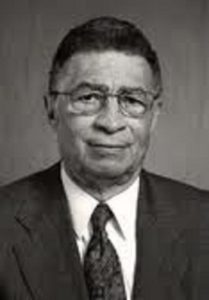
Dr. Maurice Rabb Jr.
*Dr. Maurice F. Rabb Jr. was born on this date in 1932. He was a Black ophthalmologist, author, and administrator.
Rabb, the only child of an anesthesiologist and math teacher, was from Shelbyville, Kentucky. At 16, he graduated from Central Colored High School and went to the University of Indiana because the University of Louisville was still segregated. After the University of Louisville desegregated, Rabb came home as one of the first blacks admitted into the College of Arts and Sciences. He earned a B.S. in 1954 and an M.D. in 1958 from the University of Louisville. He also studied ophthalmology at New York University.
Rabb was director of the Illinois Eye Bank and Research Laboratory of the University of Illinois Medical School. He was also director of the Fluorescent Angiography Laboratory at the Michael Reese Hospital in Chicago. Rabb received awards in 1962 and 1964 for photographic work concentrating on the physiology of the inner eye. With Dr. George Honig, Dr. Rabb founded IIIC's Comprehensive Sickle Cell Center in 1972.
For decades, the center distinguished itself as a leader in sickle cell research. Dr. Rabb served as the center's director for 16 years and accumulated over $16 million in grants during his tenure. It was through Dr. Rabb's research in the field that it became possible to prevent retinal detachment and blindness in sickle cell patients. He was chair of the ophthalmology department at Mercy Hospital in Chicago from 1971 until 2005.
He was also a highly-regarded professor, tenured since 1977, at the University of Illinois at Chicago. Dr. Rabb was the first African American ophthalmology resident at the University of Illinois Hospital and the first Black president of Mercy Hospital's medical staff. He initially dreamed of becoming a photographer. But when he realized a career in the arts might not afford him the lifestyle he was accustomed to, he chose the profession his parents wanted him to pursue without compromising his appreciation for the visual arts. "He was going through the film like it was water. A friend said, 'Man, you better attend medical school.' So he picked ophthalmology because it was related to some of his interests," said Dr. Rabb's wife, art consultant Madeline Murphy Rabb. The couple had two sons, Maurice Rabb III and Christopher Rabb.
He served as the medical director of the university-affiliated Illinois Eye Bank from 1972 to 1987, becoming the first African American physician named as a medical director of an American eye bank. Dr. Rabb was on the U.S. Food and Drug Administration's ophthalmic advisory committee in 1972. He was appointed an ophthalmic consultant for the U.S. Centers for Disease Control and Prevention to investigate the Tuskegee syphilis study. In 1974, he became the first Black to co-author a book on ophthalmology, titled Clinicopathologic Correlation of Ocular Disease, with Dr. David Apple. He wrote five books and authored more than 60 articles during his career.
Dr. Rabb was appointed to the National Advisory Council of the National Eye Institute of the National Institutes of Health in 1995. He was also a longtime member of the National Negro Medical Association (NNMA), a more-than-century-old group for black physicians. The NMA named a scholarship after him, and another prominent Black doctor called the Rabb Venable Ophthalmology Award for Outstanding Research. Dr. Maurice F. Rabb Jr died on June 6, 2005, at his Gold Coast home from complications related to lung cancer. He was 72.